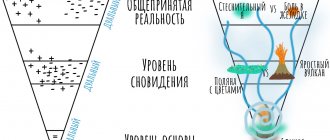For more than two years I have been going to psychoanalytic therapy - the “light version of psychoanalysis”.
I did not choose this method because before studying the relevant literature I knew nothing at all about it. I don’t want to insist on efficiency - this is a matter of many factors. In my case, the process is slow, but I feel that I am getting rid of annoying cognitive distortions, challenging them, learning to build relationships and respond to difficult situations differently. Abstract anxiety and its main symptom—panic attacks, which had tormented me since school—went away in the first six months.
Every year I am haunted by the eternal, as I call it, change of cycles: autumn and winter are always productive for me, full of ideas and the meaning of life; spring and summer are a viscous depressive background, which I tried to cope with through self-harm. All my life I have had a hard time controlling my own impulsiveness and emotional swings. I decided to try something different instead of the usual destructive way - I realized that I should trust someone.
It seems to me that the main role is played not so much by the method as by the participants in the process themselves. The relationship between two people, which unfolds within the narrow confines of a setting, is the value and goal that psychotherapists should ideally adhere to, whatever direction they prefer.
Before that, I went to a psychotherapist for an eating disorder, but it didn’t go beyond the first session. We weren't right for each other, that's how it happens. But then I was demotivated: I thought that all therapists are the same and I couldn’t find a better one. Also a kind of cognitive distortion.
I met my current psychotherapist a year later. I searched on the specialized website, went through the options, called everyone personally - I completely trusted my intuition, and not the recommendations of my friends. The best advice: do not go to the first number, but communicate in person, at least on the phone, study the information (diplomas, qualifications) and understand whether the specialist is attractive to you. This is difficult internal work, but the result is worth it.
The most interesting things begin in the office - at four consultation (introduction) meetings and directly during psychotherapy.
Psychoanalysis
There is a paradox: many people in need of psychological help look for a psychoanalyst
, but few people are ready to undergo
real psychoanalysis
. This is due to ignorance of the peculiarities of psychoanalysis.
Freud conducted psychoanalysis 6 times a week. After the transition in Europe to a five-day working week, 5 sessions per week became the standard for psychoanalysis. A very limited number of patients are ready for this, so in the USA they compromised by allowing it to be considered real psychoanalysis if the patient visits a psychoanalyst 4 times a week. The French turned out to be even more “accommodating” and “allowed” their patients to visit a psychoanalyst only three times a week, also calling this psychoanalysis.
In Freud’s time, in small, by modern standards, Vienna at the beginning of the 20th century, it was possible and even desirable for unemployed wives of wealthy burghers, who were mostly Freud’s patients, to visit their psychoanalyst 6 times a week. Moreover, the tests at that time were very short, no longer than three months (with rare exceptions). This time was sufficient, as Freud put it, to turn a neurotic into an unhappy person.
. But three months turned out to be insufficient for the recovering neurotic to adapt to the reality around him, from which he, in fact, “hid” into neurosis. Therefore, some of Freud’s famous patients were subsequently treated for a long time by other psychoanalysts.
In this regard, modern psychoanalysis lasts from several years to ten or more. Today in big cities, with their vast distances, people who spend more than nine hours at work every day do not have the opportunity to visit a psychoanalyst as often. And most people are not able to pay the fees of psychoanalysts for 5 sessions a week. In part, the requirement for such a high frequency of visits caused the crisis of psychoanalysis
, which began in the 50s of the 20th century (I described other components of this crisis in the article
What is psychotherapy?
).
What exactly does a psychologist do and where can one get the appropriate education?
Psychology, like any scientific discipline, has its own object and subject of study. The object of psychology is a person, which is indisputable. But there are different opinions about the subject, varying historically and depending on the directions of psychological research.
At first it was the soul, then consciousness, adaptability, mental activity, behavior, the unconscious in the psyche, personal and practical experience, receipt and analysis of information, as well as other aspects. All this led to the emergence of a huge number of directions and branches in psychological science. Among the main ones we can highlight such as fundamental general psychology and many applied branches of practical importance: • clinical (medical); • gender; • children's room; • military; • criminal; • judicial; • legal; • engineering; • economic; • oncopsychology.
This includes the psychology of sports, work, parenting and many other areas. In short, they are legion. But the main thing that is important for a psychologist is the practical application of acquired knowledge, the ability to help a person solve problems that arise in the family, at work, in creativity, science, study or business. The task of a psychologist is not so much to give practical advice as to help a person himself understand the current specific situation and make a choice of the correct model of behavior and attitude towards it. This approach will allow the patient to more consciously and objectively assess negative situations in the future and try to resolve any problem without entering a stressful state and making enemies. A psychologist must teach a person to resist the challenges of the modern, extremely urbanized surrounding reality, to make his psyche stable and at the same time flexible, not breaking under the influence of constant stress, but capable of finding a way out of any difficult situation with minimal losses.
In fact, an experienced psychologist can become the best assistant in solving problems of finding one’s place in life, interaction with society and spiritual comfort.
A psychologist can act in different roles, specializing in psychodiagnostics or as a consultant, trainer, coach, or psychotherapist. But the main thing is to obtain a fundamental psychological education on the basis of state universities - Moscow State University, the Russian University for the Humanities, the Higher School of Economics Research Institute; in clinical medical psychology you can get an education at medical universities named after Sechenov and Pirogov. In St. Petersburg, psychologists are trained by St. Petersburg State University, State Pedagogical University named after. Herzen. Knowledge in clinical psychology can be obtained through program training at the St. Petersburg State Pediatric Medical University, St. Petersburg State Medical University named after. Pavlova.
In addition, a psychologist's education can be obtained at regional humanitarian universities. By the way, education is one of the key points that distinguishes a psychologist from a psychiatrist. Psychiatry is a branch of medicine that requires compulsory medical education, which allows a psychiatrist to prescribe treatment and write prescriptions for medications.
The psychologist is deprived of this right and solves the problems of the patient’s interaction with the outside world using purely psychological methods.
Psychoanalytic psychotherapy
Freud predicted “ that the massive application of our therapy will force us to alloy the pure gold of analysis with copper...
“This is how Freud foresaw the emergence
of psychoanalytic psychotherapy
.
Thanks to more lenient requirements for the frequency of visits, psychoanalytic psychotherapy
turned out to be more in demand.
A patient of a psychoanalytic psychotherapist can attend psychoanalytic sessions 1-2 times a week, and will not be persuaded to switch to visiting 3-4 times a week, which is most often done by real psychoanalysts
, who believe that only such a high frequency of visits can give a good result.
I must admit that I also find a higher frequency of visits preferable to infrequent visits. With more frequent visits to the patient, psychotherapeutic work is deeper and more effective (which is why I offer larger discounts to encourage patients to come more often). But I realize that not all of my patients can afford this.
For some patients, visiting once a week is optimal; they remember well what we discussed in the last session a week ago, bring detailed stories of what happened over the past week, and do not feel the need to meet with me additionally or write to me during the week. In psychoanalysis they say that such people have a good ability to contain
(Wilfred Bion). But such patients are an exception. There are also patients for whom visiting more than once a week would be an excessive mental burden - for them, visiting once a week is optimal. But, more often than not, if the patient is motivated to solve his psychological problems and is involved in psychoanalytic work, usually one session a week is not enough, because during the week many thoughts appear and many events occur that cause different experiences that you want to share with your psychoanalyst. In this case, the duration of a single session per week is often not enough, and the psychotherapist has to constantly keep in mind what was discussed and what was not discussed in order to return to it another time (and, I must admit, it is not always possible to discuss everything during sessions). topics raised). Therefore, rare visits create certain difficulties not only for the patient, but also for the psychotherapist.
Usually, at the beginning of psychoanalytic psychotherapy, patients have a high need for psychoanalytic sessions, and if possible, they go often. As a result of psychotherapeutic work, such a need, as a rule, decreases, and the frequency of visits gradually decreases, sometimes down to once a month. The main thing is that I can accompany and support my patients over a long period of their life journey, without replacing their personal life with psychoanalytic sessions, and they will not be financially exhausted.
It happens that a patient comes to me and says that he has a set aside amount that allows him to attend my sessions, for example, 3 times a week for a year. And there are no more savings, and with his income he cannot continue psychoanalysis for a longer time. In this case, I say that it is better to go 3 years 1 time a week than 1 year 3 times a week.
The human psyche is very inert: a child is able to learn to walk confidently only by about 5 years, speak confidently by 10, write by 15. Neurosis always forms in childhood, and, in fact, always turns out to be chronic
, (if we are not talking about child psychoanalysis). Therefore, the duration of psychoanalytic psychotherapy is prioritized over the frequency of patient visits.
These words should not be understood to mean that the patient should go to a psychoanalyst for, say, three years, and only in the third year should he finally be cured of neurosis or depression. On the contrary, the first positive changes may appear within a few months, even with a visit once a week - but it takes years for sustainable results.
But such long-term psychotherapeutic work is not always necessary. There is also the so-called focal psychoanalytic psychotherapy
, which usually lasts only a few months.
A feature of this type of psychotherapy is that the analysis focuses
on one problem. Such psychotherapy is not suitable for the treatment of neurosis or depression, but helps to alleviate the affective state associated with mental trauma, for example, caused by divorce.
Psychoanalytic and psychotherapeutic factors
Freud emphasized that he developed psychoanalysis as a method of studying the unconscious
, and he considered the therapeutic effect of psychoanalysis only
a by-product
of such research.
Charles Brenner
bluntly wrote that
“no one is going to lie on a couch for 50 minutes five times a week and talk about everything that comes to mind to a stranger without a good enough reason to do so. As far as we know, the only serious motive for this is neurotic suffering and the hope of relief or cure.” But there is no desire to explore your unconscious
. At least, I do not know that any psychoanalyst I know directly spoke about this to their patients at the beginning of analysis.
In psychoanalysis, it is customary to distinguish between psychoanalytic
and
psychotherapeutic
factors.
The psychoanalytic factor is the study of the unconscious ( the “pure gold” of psychoanalysis
).
And psychotherapeutic factors aim to alleviate the patient’s condition, first of all, through support ( “admixtures” to psychoanalysis
).
The predominance of supportive
interpretations (psychotherapeutic factor) relative to
expressive
, insight-oriented ones (psychoanalytic factor) is a characteristic feature of psychoanalytic psychotherapy, distinguishing it from psychoanalysis.
Therefore, psychoanalytic psychotherapy is also called expressive-supportive psychotherapy
.
Very few patients are ready to receive only the “pure gold” of psychoanalysis
.
So psychoanalyst Frederick Perls
escaped from
the “pure gold” of psychoanalysis
and founded a new type of psychotherapy with a lot of “impurities”,
Gestalt psychotherapy
.
It is interesting that, judging by historical facts, Freud was very friendly to patients and could build trusting, close and deep relationships with patients. That is, Freud himself already used “ admixtures
"to psychoanalysis, without which there can be no
therapeutic effect
.
Another distinctive feature of true psychoanalysis, oriented towards the study of the unconscious, is the provision of space
for the patient to explore his unconscious.
It is believed that if the psychoanalyst talks less, this will give the patient the opportunity to independently analyze his unconscious, i.e. work analytically
.
In support-oriented psychoanalytic psychotherapy, much greater activity of the psychotherapist is allowed if the patient needs it. For example, for depressed patients, the silent psychoanalyst
turns out to be a “
dead mother
” (André Greene), resulting in
iatrogenic retraumatization of the patient
.
Judging by the transcripts of psychoanalytic sessions that have come down to us, Freud was not a particularly silent psychoanalyst. However, the silence of psychoanalysts
became the talk of the town. But when the psychoanalyst is silent, the patient lying on the couch, not seeing the psychoanalyst, may fear that the psychoanalyst has fallen asleep.
Transpersonal therapy
Returning to the original meaning of psychology - the doctrine of the soul (Greek psyhe - soul, logos - teaching, science), transpersonal psychology considers caring for the soul as the primary task of psychotherapy. Transpersonal psychology is a direction that focuses attention on the deep areas of the psyche, the processes of personality development and the dynamics of consciousness, philosophically rethinking and scientifically substantiating the ideas, experience and psychotechnologies of world spiritual traditions. The object of research and practical paradigms and projects of transpersonal psychology is a creative, self-improving person striving for the full and adequate realization of his capabilities.
Transpersonal psychology studies consciousness in a wide range of its manifestations: altered states of consciousness, multiple states of consciousness, spiritual crisis, near-death experiences, development of intuition, creativity, higher states of consciousness, personal resources, parapsychological phenomena. It is based on a holistic vision of man in the perspective of his spiritual growth, classical and non-classical philosophical anthropology, world spiritual traditions, various methods of self-knowledge and psychotherapy, such as meditation, holotropic breathing, body-oriented psychotherapy, art therapy, working with dreams, active imagination, self-hypnosis, etc.
If in classical psychological and psychotherapeutic approaches, for example, in psychoanalysis, a person’s problems are considered only at the biographical level, then in transpersonal psychotherapy a broader approach is used, which includes, in addition to the biographical level, the perinatal (history and experience of birth) and transpersonal (superbiographical) experience that includes human experiences: stories of ancestors, phylogenetic experience, world culture; experiences of identification with plants, animals, other individuals, with various forms of consciousness - from identification with individual organs to planetary consciousness; archetypal experiences and awareness of sacred knowledge) .
Transpersonal psychotherapy is based on the idea of the possibility of realizing a person’s internal, deep transpersonal potential for healing and mental health, for personal and spiritual growth through the awareness and experience of a person’s unsatisfied and unrealized desires, the transformation of the negative consequences of the perinatal period of life, and traumatic events. This is the value of the transpersonal approach - not only to help solve a person’s deep-seated problems, but also to release colossal internal developmental and self-healing potential (resource), as well as teach how to use it.
A wide range of methods and integrative psychotechniques are used to discover and develop the internal transpersonal resource. Collectively, they aim to establish balance and harmoniously merge the physical, emotional, mental and spiritual aspects of a person. Below is a brief overview of the main methods of transpersonal psychotherapy.
From the point of view of the transpersonal approach, a person’s mental state is directly influenced by his physical state of health. Therefore, in addition to traditional health procedures - diet, sports, etc., usually recommended during therapy, the transpersonal approach uses body-oriented techniques - Lowen bioenergy therapy, sensory awareness, dance therapy, various yoga exercises, tai chi chuan, oriental martial arts. Such techniques allow you to better understand the relationship between body and soul, establish a relationship between them and establish a mechanism for self-healing of physical diseases through awareness and subsequent transformation of the problem. Awareness and subsequent liberation from bodily blocks and clamps allows the person undergoing therapy to feel more relaxed, due to this in the future more calm, free, and therefore able to recognize and solve their problems at a higher level of consciousness.
Methods of working with emotional problems in transpersonal psychotherapy most often use various technical techniques that cause altered states of consciousness, which ensure the emergence of emotional catharsis and transpersonal experiences. Basically, to achieve altered states of consciousness, various breathing techniques are used - rebirthing, holotropic breathing, vibration.
To free yourself from emotional blocks, the techniques of Gestalt dialogues, guided imagination - creative visualization of Shakti Gawain, techniques for working with dreams developed by S. Laberge, a creative approach to dream analysis described by S. Krippner and others are used. Usually, psychologists who do not have a transpersonal orientation consider working with dreams as a short and simple path leading to the unconscious, without taking into account the hidden colossal potential that provides access to transpersonal areas of consciousness.
Transpersonal psychotherapy also uses methods of existential therapy - helping clients solve problems of choice, meaning, freedom, responsibility, love, death, etc.
In addition to using the above psychotherapeutic methods, transpersonal therapists use techniques taken from ancient spiritual practices - mental exercises and meditation. By learning in the process of transpersonal therapy new patterns of relationship to oneself and the environment through awareness, that is, learning to comprehend experiences differently, a person develops consciousness. In the process of reflection, cognitive rethinking occurs, which allows you to transform many problems, repressed information and learn a more holistic and free existence.
Meditation training can successfully complement the development of human consciousness, develop attention and concentration. The practice of meditation successfully complements transpersonal therapy, allowing you to effectively work with the state of anxiety caused by the repression of important experiences for the client into the unconscious.
One of the features of transpersonal therapy is that when choosing techniques to work with, the psychotherapist takes into account both personal characteristics and universal – transpersonal ones. Therefore, just as transpersonal ideas about a person and his environment are broad, so are the methods used in the practice of transpersonal therapy.
Traditional methods of treating drug addiction - medical detoxification and/or psychological support with rational methods of psychotherapy - are ineffective, this is confirmed by growing statistics. This is explained by the multi-level nature of the problem of drug addiction. As has been experimentally proven, this is explained by the fact that at a deep, unconscious level, the individual remains psychological (emotional) dependent on the states given by the drug - an altered state of consciousness.
Every person initially has a need for altered states (escape to another reality). In an altered state of state (ASS), the human brain operates in different modes. In ASC, a person gains access to his resources. There are cases when, under the influence of strong experiences, a person performed actions that were impossible for him in a normal state of consciousness. Over the course of many years of evolution, people have used trance states for survival, gaining knowledge, and pleasure. People get pleasure through extreme states, engaging in dangerous sports, entering a state of trance, drinking alcohol and drugs.
The states of expanded consciousness achieved during the trainings are close to mystical experiences, full of psychospiritual and existential discoveries. Often, with the help of immersions in the process of connected breathing, a person gets rid of psychosomatic diseases, ceases to be aggressive, and begins to feel harmony with people and nature. Going through the stages of integration, a person’s personality becomes holistic.
Using the methods of transpersonal psychotherapy, liberation from destructive addictions is much easier and faster, thanks to sacred experiences and legitimate transcendence of the ego.











